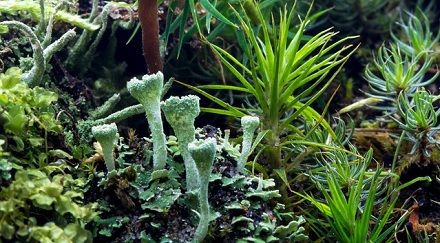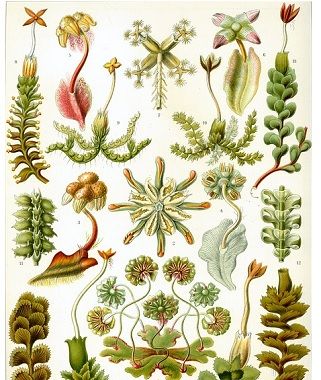Liverworts and Mosses are the non-vascular and non-flowering plants that are found in wet and terrestrial environments. Though numerous essential differences lie between them. For instance, Liverwort belongs to the division – ‘Marchantiophyta‘ or often term as’Hepaticophyta’, while mosses fall under division – ‘Bryophyta‘.
Secondly, liverworts have thallus or foliose that are green leaf-like arrangement hook-up with the stem, whereas mosses are simple, small and leafy arrangement present around thallus that display spiral or radial symmetry.
Non-vascular plants like hornworts, liverworts and mosses and some algae, are categorized as plants which are very small in size and do not have the functionality like the advanced plants have; As these plants lack the transportation system for the exchange of gases and waters and other material. These plants do not bear fruits, flower or wood. Non-vascular plants reproduce by spores instead of seeds.
Although the non-vascular plants have specific specialized tissue for the transportation of waters and other materials, as lignin is absent in these tissues and so they are not categorized as true vascular tissue like those found in ferns, gymnosperms, angiosperms and lycophytes.
In this article, we will be going to take the points that differ the liverworts from the mosses and also a brief discussion on them.
Content: Liverworts Vs Mosses
Comparison Chart
| Basis For Comparison | Liverworts | Mosses |
|---|---|---|
| Meaning | Liverworts have lobed or dichotomously branched thallus, which is dorsoventrally flattened. | Mosses have a structure similar to stem or thallus that is leafy and show spiral or radial symmetry. |
| Division | Liverworts are associated with the division 'Marchantiophyta'. | Mosses are associated with division 'Bryophyta'. |
| Leaf arrangement | The structure similar to the leaf of the liverworts exhibits the flattened patterns forming two to three rows. | The structure similar to the leaf of the mosses exhibits the spiral or whorl type pattern. |
| Examples | Porella, Riccia and Marchantia fall under liverworts category. | Sphagnum, Funaria and Polytrichum are categorised as mosses. |
| Other features | The liverworts can be foliose or thallose. | The mosses are foliose. |
| The body of a plant is dorsiventral. | The body plant is radial. | |
| Leaves if present, do not have midrib. | The plants are always leafy, having midrib on the leaves. | |
| Dichotomous branching is found. | Extra-axillary and lateral branching are present. | |
| The rhizoids of the plant are unicellular. | The rhizoids of the plant are multicellular. |
|
| Scales or amphigastria are found. | Scales or amphigastria are not found. | |
| Sporogoninum had few green tissues and cannot synthesize its food. | Sporogonium has plentiful of green tissue and can synthesize its food. | |
| The growth of seta is rapid for the maturity of spores. | The growth of seta is slow and gets ultimately develop before the maturity of spores. | |
| Elaters are present but not in Riccia. | Elaters are absent. | |
| Peristome teeth are absent. | Peristome teeth are present in the apical region within the capsule. | |
| The columella is absent. | Sterile columella is present in capsule. | |
| Protonemata is absent in liverworts. | Mosses have filamentous protonemata. |
|
| Chlorophyll and stomata are absent. | Chlorophyll and stomata are present for gaseous exchange in the sporophyte. | |
| Sex organs are present on the dorsal side of the thallus, that grow from the superficial cells. | Sex organs grow at the apex of the leafy gametophyte from the superficial cells. |
Definition of Liverworts
Unlike the other plants, liverworts differ from the typical plant by having a single layer of the cells. They also vary by not having stomata, which has the use of gaseous exchange for the process of photosynthesis in the advanced plant.
Liverworts can be leafy or thalloid, and the first one is the simple form of the species by the latter one has the complexity as they have multiple thick layers of green tissues known as thallus.
Liverworts are the flattened plants that grow across the upper layer of soil, mountains, rocks and on the other plants. The dominating phase is the gametophyte, while the sporophyte phase occurs for a short duration.
Instead of the roots, liverworts have rhizoids, which are hair-like structure and support the plant in anchorage to the surface, and in absorbing water. So, liverworts have two parts the upperside and upper. First one is for photosynthesis, and so it is green in colour, while the second part consists of the rhizoids.
As discussed above, the liverworts belong to the division ‘Marchantiophyta‘, and makeup around 8000 relatively diverse species all around, out of which majority is of the leafy liverworts species.
The division ‘Marchantiophyta’ of the liverworts has two class also that are ‘Jungermanniopsida‘ with the subclasses as ‘Jungermanniidae‘ and ‘Metzgeriidae‘. The second class is the ‘Marchantiopsida’ that has subclasses as ‘Marchantiidae‘ and ‘Sphaerocarpidae‘.
Earlier, Liverworts were also categorized under ‘Bryophyta’ with Hornworts and Mosses, but with the in-depth research and gaining knowledge about them, they (liverworts) were classified under different class.
The plant reproduces by using spores, for the fertilization process, the sperm travel through water or wind to the egg of the other plant. The fertilized eggs develop into spores and get dispersed.
Definition of Mosses
Likewise the liverworts, Mosses also have rhizoids and reproduce by spores. Mosses are present in wet environments like alpine, rainforest and wetlands. These can be commonly seen in wet areas and grow their colonies on sidewalks, brick walls, driveways and other human-made structure. Their favourable condition to grow is the wet climate.
Mosses are categorized under the division of ‘Bryophyta‘ and have sub-division ‘Musci‘. There are approximately 14,500 species of the mosses found all around the world and constitutes around 75% of the total Bryophyta species.
The gametophyte containing sperms cells are covered by the thin layer of water, travel to another gametophyte for fertilization with eggs. The fertilized egg will grow into a sporophyte, which will later develop into spores.
Therefore, it is said that the gametophyte generation is longer and dominant over the sporophytic generation and develops on the nutrition and water provided by the gametophytes.
Key Differences Between Liverworts and Mosses
Following are the essential points to differentiate the liverworts and the mosses:
- Liverworts have lobed or dichotomously branched thallus, which is dorsoventrally flattened, on the other hand, Mosses have a structure similar to stem or thallus that is leafy and show spiral or radial symmetry.
- Liverworts are associated with the division Marchantiophyta, whereas Mosses are associated with division Bryophyta; Though they both are the non-vascular plants.
- The structure is similar to leaf in liverworts that exhibit the flattened patterns forming two to three rows, while in mosses that show the spiral or whorl type pattern.
- Examples of the liverworts are Porella, Riccia and Marchantia, while Sphagnum, Funaria and Polytrichum are categorised as mosses.
- The liverworts can be foliose or thallose, whose body is dorsiventral and flattened, whereas the mosses are foliose and the plant body is radially symmetrical.
- Leaves if present, do not have midrib in the liverworts, while mosses are always leafy, having midrib on the leaves.
- The rhizoids of the liverworts are unicellular, but they are multicellular in mosses.
- In liverworts scales or amphigastria are found, and sporogonium had few green tissues and cannot synthesize their food. On the other hand, in mosses, scales or amphigastria are not found, and sporogonium has plentiful of green tissue and can manufacture its food.
- Elaters are present but not in Riccia in liverworts, though elaters are absent in mosses.
- Peristome teeth, columella, protonemata, chlorophyll and stomata are absent in liverworts. However, if we observe the mosses, peristome teeth are present at the apical region within the capsule, Sterile columella and filamentous protonemata are also found. The chlorophyll and stomata are also present in the sporophyte.
- Sex organs are present on the dorsal side of the thallus, that grow from the superficial cells in case of liverworts. Whereas, sex organs grow at the apex of the leafy gametophyte from the superficial cells.
Similarities
- Liverworts and mosses are the non-vascular and non-flowering plants.
- These plants grow in wet environments and terrestrial area.
- The gametophyte phase is always dominating then sporophyte phase.
- Sporogonium is separated into capsule, foot and seta.
- Both types of plants contain chloroplast per cell.
- Both types do not have true leaves, stems or roots.
- They lack stomata and cuticles.
- The fertilization is water-dependent.
Conclusion
In this article, we came to know about the non-vascular plants which are liverworts and mosses, on which points they differ and how are they similar. We also discuss their structure and their method of reproduction.
Also, such plants are essential to the environment, as they are the habitats of the many insects and invertebrates. They are also the food source for many of them. They also help in retaining and filtering water, and removes CO2 and stabilizes the ground.





MARK GLENN DALURA ELBIT says
Thank you!